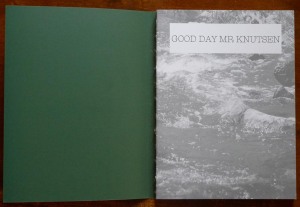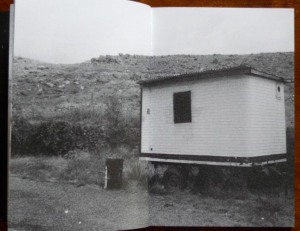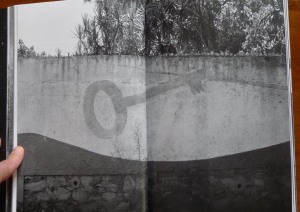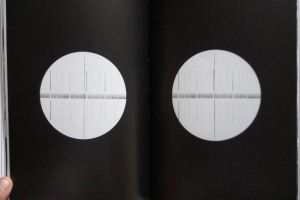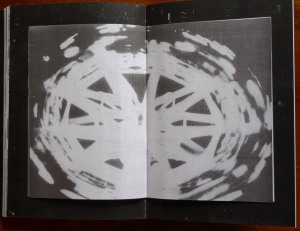Good day Mr Knutsen, by Eric Gunderson
Posted: November 29, 2014 Filed under: Photobooks Leave a commentFinally got some time to post a note about this book, from my fellow photobook collector and blogger Eric Gunderson, published in 2014 through his young publishing house Jameric Editions (if you know him, you’ll easily understand where the name comes from). Softcover book, 17 x 23 cm, 72 pages, black and white photos.
Have you ever met Mr Knutsen ? Who ? You know… the man living upstairs, just up in the street, behind this strange pine tree ! We say hello everyday and have a little chat… Oh yes, the guy who looks like this old French President, what was his name… Jacques Chirac, that’s right.
We met each others, almost everyday, for years now, and today for the first time, I am going to spend some time with Mr Knutsen. A couple of weeks ago, he offered me to go with him to one of his favorite place outside the town. Well, the opportunity to spend a little more time together or, to better say, to try to know each other.
This book is like a novel. It begins when we arrive in front of the house. We climb the stairs and discover Mr Knutsen still in bed. Time to dress, to feed the cat and we jump in the car for a trip in the countryside. What I like in the book is its minimalism. It is not about the extraordinary or some kind of concerned photography. The book focus on what we all do everyday, about what are our joys, our little pleasures, our smiles and laughs, and finally, it tells about our knowledge of each others. What we share becomes a kind of intimacy : the walk beside a river, swimming in the water, cutting a branch, playing with a plastic cup… It is about what it represents to live in a society surrounded by other people, some that we ignore, some that we know, and some that we love. Each relationship is unique, depending on that level of sharing.
One of the great quality of the book is the sequencing. It creates a rhythm which alternates calm moments which suddenly speed up. We’re having great fun with Mr Knutsen and we easily imagine that we were quite silent in the car on the way back, exhausted after so much excitation and a bit sad to come back to daily life. The cat enjoys the return of Mr Knutsen, and at the end of the day, he stands on his balcony to look at the street where I disappeared. 

I also have to say that I like the style of the photographs, varying from close up to larger views, depending on the proximity with Mr Knutsen, focusing on details that caught our attention (the cat, a branch, the plastic cup…). Some of these photographs are strongly composed and, for my great pleasure, some are weaker, which makes sense, giving some breaths in the rhythm. The book works so well, that we feel sad when the book comes to its end, and we flip back through the pages to remember some good moments…
So yes, we had a good day Mr Knutsen !
More info : http://jamericeditions.com/
All images copyright Eric Gunderson and Jameric Editions.
And just for the pleasure, kind of making of, a photo which does not appear in the book : Mr Knutsen waiting for my arrival…
Where mimosa bloom, by Rita Puig-Serra Costa.
Posted: November 14, 2014 Filed under: Photobooks Leave a commentOn the cover of the book, an old family photo, almost faded away. The slow disappearance process of an image shows the counting of time. It reflects the process of the memory which slowly erases the continuum of a life.
Where mimosa bloom is a book about the loss of a beloved one who died too young, the mourning and the grief, but it is also about how a parent, in this case, a mother, acts to help a child to construct herself. At the end of the book, a two pages long text, written by Rita, is a wonderful tribute to her beloved mum, in the form of a farewell letter.
Reading this book, is like spending an afternoon with Rita when she decided to explore the photographic archives of the family. The kind of boxes we all have at home, and in which, year after year, we go back to dig an almost forgotten piece of the family memory. You can almost hear someone mention an anecdote related to the image. Photos and objects came up in no particular order, and that’s the beauty of the process. We don’t follow the story, but a new piece of the puzzle enlightens something glimpsed earlier.
The book opens with a genealogy tree of the family. 5 pages with holes, reveal three generations : the organisation of the family with her mum in the middle, the parents, brother and sister, and Rita, at the bottom. This is like the cast of a movie, a clue of what we’ll find in the following pages, emphasizing a story to be built.
The organisation of the book is an alternance of contemporary photographs of family members, interlaced with objects preserved as treasures, and old photographs from the family « box » mentioned above. All the people portrayed are staring off-camera (except one), with modesty, to let the memories outcrop, they’re concentrated, maybe on the remaining souvenirs, sharing all together the sadness of the mourning process.
One of the last photos in the book is a broken statue which, despite its degraded state, exudes an everlasting beauty, a metaphor of the disease which destroyed her mum : whatever the death can do, the souvenirs will remain beautiful.
This book resonates with me for two personal reasons. The first one is very basic : like Rita, my mum passed away and I find a lot of similarities with her history, even if the cultural background is completely different. To share a story may help to overcome the grief process, both for the author and for the reader and the catharsis may operate.
The second deals with the title which I find beautiful. I was raised in the Southern part of Bretagne in France. A protected area which has a particular climate allowing palm trees and mimosas to grow and flourish. Winters are never cold there, but they are rainy, wet and grey. In February, the first sign of the revival is when mimosas bloom. The metaphor of life, erasing all the pain and suffering. It is the time of the year to start gardening again. The cycle of nature operates to refurbish each of us in energy and faith for a brighter future symbolized by the summer to come. The time of an accomplished Farewell.
Hardcover book, published in 2014 by Editions du Lic, 96 pages with 54 photos. 16 x 22,5 cm. Print run of 460 copies.
More info here : http://www.ritapuigserra.com/
To buy the book : http://editionsdulic.com/products/where-mimosa-bloom
Another review of the book : http://lastrespreguntas.wordpress.com/2014/08/01/where-mimosa-bloom-english-version/
All images copyright Rita Puig-Serra Costa and Editions du Lic.
Intergalatico, by Guilherme Gerais
Posted: November 8, 2014 Filed under: Photobooks Leave a commentAt first sight, the book does not look like a photobook. You could easily imagine finding it in the middle of the shelves in the esoteric area of a public library. But at the same time, the cover has a strong design, very attractive ! You understand immediately that you will not find banality inside.
Hardcover book with the inner spine half attached to make it easy to open and read. Apart from the cover, every photos and drawings are in black and white. 20 x 30 cm, 184 pages with photos by Guilherme Gerais and illustrations by Arthur Duarte. Published by Avalanche.
Well, it is not an easy book to review because, in my opinion, it refers to the unconscious, thus everybody will have his own reading and his own discovery.
The book begins with a series of grainy photos with a kind of crosslinking effect. Inserted between the pages you find a card with an introduction text which resonates like a voice, heard while looking at the photos. In a very cinematographic way, it works like a pre-generic of a film. Your view is blurred, the scale changes. You understand you’ll have to be available for a journey in the unknown. After this sequence of 9 pictures, you finally discover the title of the book which does not appear on the cover. If you’re a bit fast, you may even miss it !
So the trip begins here, with the title. To explain further what is inside the book, I have two references in mind. The first one would be the surrealists with all their collage experimentations. The book works with series of photos or illustrations which alternates and sometimes reappropriate a visual: footprints interlace paving stones, a pancake on a screen print… And between each series a drawing which sends us back to an esoteric world made of unconsciousness, astrology, tarot cards and predictions. It is like exploring a world made of rooms in which you enter passing through different doors. You never know what you’ll find behind the next door, even if it is already written somewhere in your mind.
All those impressions are strongly reinforced by the choice of the views. On a photo, you discover a key, in some others, you find a path which attracts you like a magnet. Somewhere else in the book, you’re lost in a desert with the shadows of vultures watching you ; you almost feel thirsty and exhausted…
The second reference I have in mind is the book written in 1968, “The teachings of Don Juan” by Carlos Castaneda. I don’t know if it has anything to do with the fact that Guilherme Gerais is a Brazilian photographer, so Latin America shares spiritual knowledges, but the book becomes an initiatory journey (I have, here, no interest in the controversy about Castaneda’s book, knowing if the book was an anthropological essay or a novel). The sequencing of the book drives you through series from an asleep to an awake state. Your view is blurred and the reality becomes altered, the scales flip your mind, then you suddenly concentrate on a detail, and the landscape, or the room, around becomes incredibly focused; your view is accurate as never before and you discover an augmented reality. Things you’ve seen print in your mind, built a memory made of interlaced objects. It creates a confusion between the past, the present and the future. You don’t know if you’ve seen it before or if it is a foreknowledge.
And last detail, if this was not enough, you find a little booklet inserted at the end of the book. The booklet seems to be made of rayograms (another reference to surrealists), shadows and stellar recordings. A kind of sketchbook done during the experience, the memory put on paper, traces engraved, an uncertain proof of an uncertain reality. Those images remind me the so-called photos of the Loch Ness monster: a representation of what we expect to see !
By what I have written above, you may understand that Intergalatico is a very strong and innovative work, but to fully appreciate it, you have to make you available for it. But once you’ve entered it, the book becomes addictive and you create your own reading, flipping randomly through pages.
More info on Guilherme site : http://www.guilhermegerais.com/
While visiting the Tipi Bookshop in Bruxelles, I have seen copies on the counter, so you may also buy it there : http://www.tipi-bookshop.be/
Guilherme will be signing his book at L’Ascenseur Végétal, on Saturday 15 November, during Le Photobookfest in Paris : http://www.lephotobookfest.com/
All images copyright Guilherme Gerais and Arthur Duarte.

